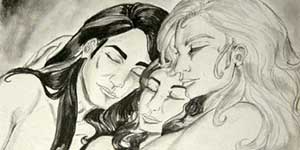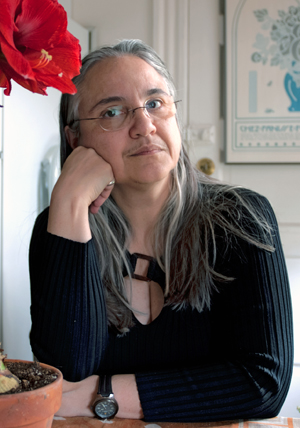Anticipated in 2014
Sunday, January 26th, 2014“She headed back east, into the gates of dawn.”
— Athena Andreadis, ending of Contra Mundum
 It has become almost obligatory for bloggers to do “last year’s best and worst/next year’s resolutions” in late December or early January. Never much a fan of such lists, I will instead share with you what I look forward to in 2014. Mind you, these are concrete items – I won’t bother with “less misogyny/more equitable structures” or equivalents.
It has become almost obligatory for bloggers to do “last year’s best and worst/next year’s resolutions” in late December or early January. Never much a fan of such lists, I will instead share with you what I look forward to in 2014. Mind you, these are concrete items – I won’t bother with “less misogyny/more equitable structures” or equivalents.
1. Greek bookstores and publishers are starting to offer e-books: water in the desert to the parched exile, book addict that is me. I will finally make a dent in the lengthy list I compiled with a longing I thought would remain unrequited. Also, I intend to renew my forays into contemporary non-US literature, with Susan Lanigan’s White Feathers high on the list.
In mystery, I have a guilty jones for the next Provincetown tale by Jon Loomis, as long as he doesn’t shear any of the black sheep milling around the goody-two-shoes Frank Coffin. In SF, much as I dislike sequelitis, I’m curious for the continuation of Up Against It by Laura Mixon (Morgan Locke), which I briefly discussed in Space Operas and Gender Shoals. It’s my fervent hope that in the sequel we’ll see much less of Geoff and much more of the troubadour troublemaker Vivian/Thondu wa Macharia na Briggs – a walking seal of approval for advanced gene splicing and a shapeshifter across all phenotypes, including gender.
ETA: And how could I forget — the conclusion of Noelle Stevenson’s Nimona comic, the only pastiche I have ever not just liked but grown attached to (though I have a bad feeling about the fate of its protagonists).
2. The final installment of Peter Jackson’s The Hobbit. This may come as another surprise, since I made it plain how much I detested the opus in Hagiography in the SFX Age. The sole reason I’m eager for part 3 is that I’m curious if my hunch about Tauriel is correct.
I predict that Tauriel will die alongside Kili in the Battle of the Five Armies. Women are dispatched casually in (space) operas and sagas but they’re dispatched with particular glee and sadism when they dare to mate with men who are shorter, younger, poorer or more marginal than they (see: Brunnhilde, Padmé Amidala). Mind you, Kili is a Dwarf prince (though from the inferior maternal line) whereas Tauriel is as low-ranking as an Elf can be – she would be working class if Elves had such a group. But since Tolkien made Dwarves literally the children of a lesser god, you get the gist. Plus it will make the canon purists happy.
3. On the other hand, I look forward to seasons 2 to N of Elementary. The series has only gone up in my initial high estimation: Jonny Lee Miller is still a white-hot Holmes, Lucy Liu’s Watson is now an equal partner and the acerbity between the two stings like good balsamic vinegar. I could use a bit less of the pious recovery platitudes and quite a lot more of both Rhys Ifans’ Mycroft and Natalie Dormer’s Moriarty (who was far more interesting in her most recent appearance than the monochromatic and rather dim villain of the season 1 ending).
4. The concluding game of the retro-RPG Eschalon series (*taps foot*). Yes, Virginia: though of the female persuasion, I’m an avid gamer — strictly solo, multigaming leaves me colder than Olympus Mons in Mars. This finale has been long in the making, but the care put in its older siblings and the preliminary preview noises suggest strongly it will reward the wait.
5. More of the perfumes conjured by Grand Magistra Dawn Spencer Hurwitz. Dawn dedicated two evenings of sampling and measuring to make personal perfumes for me and the Copper Yeti way back when the world was much younger and Newbury Street was the abode of real art and artists. My scent is The Long Shadow, a dark elixir of opium, amber and sandalwood grounded by petitgrain; his is The Cuddly Crusader, a sandalwood/musk sharpened by bay rum, cedar and juniper berries. Dawn has since become justly famous, and I never tire of sampling the fruits from her meticulously cultivated scent orchard.
6. Sarma, the appetizer-oriented restaurant just opened by fusion wonder Ana Sortun whose departure from Casablanca was a cause for universal lamentation. The iconic Casablanca itself is now closed, another blow from which Harvard Square will not recover after the loss of Wordsworth, HMV, and all non-chain small stores that gave it distinction and taste. Sortun’s first solo venture, Oleana, ushers you into paradise (literally, since she explored and reinterpreted less-frequented nooks of Armenian, Persian and Turkish cuisine) but it’s a bit too formal. The new place promises a looser atmosphere – so my QC squad is donning bibs even as we speak.
7. The new-new wing of the Museum of Fine Arts (I can hardly wait to see Fired Earth, Woven Bamboo) and the sui generis explorations of the Peabody Essex. The latter has mounted truly unforgettable boutique exhibits – from a comprehensive collection of Joseph Cornell’s haunting box assemblages to an in-depth retrospective on Maori ta moko.
8. Delve more deeply into composers I like – from Sofia Gubaidulina to Zoë Keating (who, I just found out, has composed music for Elementary. Purr, purr). And continue picking new likes from hearing snatches of music in unlikely places, which is how I bumped into Gorecki… Radio Tarifa… Fleet Foxes…
9. A possible brief sojourn in Aotearoa. I’d like to stand on some of the beaches, glens and glacial meadows I first saw in Xena and Mr. Snacho’s photos, later in The Piano and LotR. There’s a danger associated with this: the Copper Yeti criss-crossed both North and South Island for six months in another life and is threatening to lose our passports once we’re there.
10. Reading submissions for the successor to The Other Half of the Sky. Tentatively titled Dreaming the Dark, it will focus on women scientists from cultures and futures past the “girls don’t/shouldn’t do science” knuckledragging stage, and on worlds where science is more nuanced than the standard SF binary of either hubris or triumphalism. I already have my gaze fixed on writers whose work I want to see in this compilation. You know who you are.
11. Writing a necklace of linked stories for a Spider Silk universe collection. Readers have caught glimpses of this world in Dry Rivers, Planetfall, The Wind Harp and The Stone Lyre – but these are foam flecks on a Hokusai-height wave.
12. And, of course, more interviews with cryptids, having started on a high note with a saber tooth tiger.
Images: top, scaling — yet more — castle walls (photo by Peter Cassidy); bottom, a Delta 2 launch.








